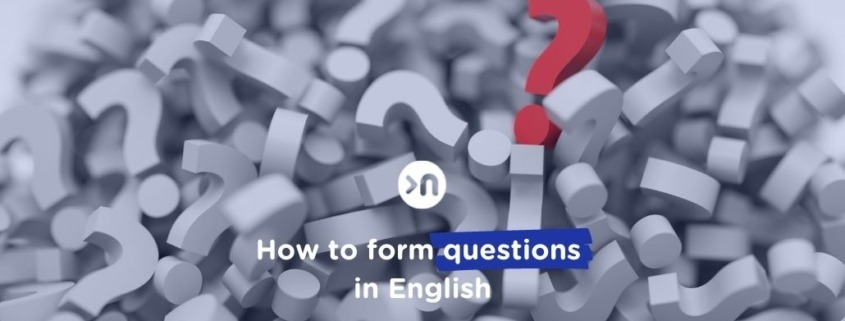How to form questions in English
How to form questions in English. Each language has its own way of asking questions, and it can be difficult at first to learn the different structures. Today we are going to learn about how to ask questions in English. We know that this is a topic that generates some confusion, especially because in English they’re done in reverse, that is, the order of some of the words is changed when going from the affirmative to the interrogative.
We are going to learn about how to ask questions in English, you have no idea how simple and useful this is. If you’re going on a trip abroad, knowing vocabulary and being able to ask questions is essential.
There are two types, and they are articulated differently. Let’s start with the easiest ones, the yes or no questions, also known as closed questions.
Closed Questions
These types of questions require a ‘yes’ or ‘no’ response. In Spanish, you simply put a question mark at the beginning and the end of a question to mark that a question is being asked. In English, you start a question with a verb.
They are formulated with an auxiliary verb (‘be’, ‘have got’ or ‘to do’)
With verbs ‘be’ and ‘have to’: verb + subject + noun, adjective…?
- Is she clever?. Yes, she is. (¿Ella es lista? Sí, lo es.)
- Have you got a car?. No, I haven’t. (¿Tienes un coche?. No, no tengo.)
With the other verb: auxiliary verb (to do) + subject + main verb + noun, adjective…?
- Does he work in a coffee shop? No, he doesn’t. (¿Trabaja en una cafetería?. No, no trabaja en una cafetería.)
- Did you like Amsterdam?. Yes, I did. (¿Te gustó Amsterdam?. Sí, me gustó.)
- Do their cats playing with you?. Yes, They do. (¿Juegan tus gatos contigo?. Sí, lo hacen.)
Open Questions
These are those questions that cannot be answered with a simple ‘yes’ or ‘no’, they require information, a description, an explanation or any other type of information.
To ask these types of questions you have to use interrogative pronouns or “question words”. There are two types of questions: questions of the subject and questions of the object.
- What….?. What do you want?/¿Qué…..? ¿Qué quieres?
- Where…? Where do they live?/¿Dónde…? ¿Dónde viven?
- When….? When do you go to work?/ ¿Cuándo…? ¿Cuándo vas a trabajar?
- Who….? Who is she?/ ¿Quién es….? ¿Quién es ella?
- Whose…? Whose book is this?/ ¿De quién es…? ¿De quién éste libro?
- Why…? Why are they there?/¿Por qué…? ¿Por qué están ellos allí?
- Which…? Which car is this?/¿Cuál…? ¿Cuál es éste coche?
- How…? How are you?/ ¿Cómo…? ¿Cómo estás tú?
With the verbs ‘be’ and ‘have got’: interrogative pronoun + verb + subject + noun, adjective…?
- What are you doing? (¿Qué estás haciendo?)
- Where are you? (¿Dónde estás?)
- When is she available? (¿Cuándo está ella disponible?)
- What have you got in your suitcase? (¿Qué tienes en tu maleta?)
- How are the cake? (¿Cómo está la tarta?)
With the other verbs: interrogative pronoun + auxiliary verb (to do) + subject + main verb + noun, adjective…?
- Where does he study? (¿Dónde trabaja él?)
- What do you like to drink? (¿Qué te gusta beber?)
- Why do you work here?(¿Por qué trabajas aquí?)
- When do you go on vacation this summer?( ¿Dónde vas de vacaciones este verano?)
Also, unlike in Spanish, prepositions are usually found at the end of the question
- What are you thinking about? ¿En qué estás pensando?
- Who are you laughing at? (¿De quién te estás riendo?)
- Where is he driving to? (¿A dónde conduce ella?)
Questions of the Object
Object questions are used to ask for information about the object or supporting feature. Look at this example:
- Julia hugged Mary. ( Julia abrazó a Laura).
As you can see, Julia is the subject and Mary is the object. If you wanted information about the object the question would be “who did Julia hug” and the answer would be “Mary”.
To ask questions in English, follow this kind of structure: Interrogative pronoun + auxiliary verb + subject + verb (infinitive)… ?
Question: Who did Julia hug?.- The interrogative pronoun “Who” is the object of the question.
Answer: Mary (Julia hugged Mary).- The answer is the object
One point you have to keep in mind when asking questions in English is that the auxiliary will change according the verb tense in which we want to ask.
- ¿A quién abraza Julia?- Who does Julia hug? (present simple)
- ¿A quién abrazaste ayer? – Who did you hug yesterday? (Simple past)
- ¿A quién abrazará Julia mañana? – Who will Julia hug tomorrow? (future)
- ¿A quién abrazarías? – Who would you kiss? (conditional)
- ¿A quién está abrazando Julia? – Who is Julia hugging? (present continuous)
- ¿A quién estabas abrazando ayer? – Who were you kissing yesterday? (Past continuous)
- ¿A quién ha abrazado Julia? – Who has Julia hugged? (Present past)
Look!
If the verb is accompanied by a preposition, it is placed at the end of the question.
- Who did you watch the movie with? (¿Con quién viste la película?)
- What do you laugh at? (¿De qué te ríes?)
Questions of the Subject
They are questions that arise when you want to ask for information about the subject. Continuing with the example before, the subject question would be “who hugged Mary?” to which we would answer “Julia”
These types of questions in English follow this type of structure: Interrogative pronoun + verb + object…?
Question: Who hugged Mary?- The interrogative pronoun “who” is the subject of the question.
Answer: Julia (Julia hugged Mary).- the answer is the subject.
- Who hugges Mary? – ¿Quién abraza a Mary?
- Who is hugging Mary? -¿Quién está abrazando a Mary?
- Who hugged you? -¿Quién te abrazó?
- Who was hugging you? -¿Quién te estaba abrazando?
- Who will hug you? – ¿Quién te abrazará?
- Who would hug Mary? -¿Quién abrazaría a Mary?
- Who has hugged you? -¿Quién te ha abrazado?
Once you have a basic understanding of how to ask questions in English, you can start asking all kinds of questions. This is an introductory post, as we always tell you, to really learn English, enrol into a language centre.









Leave a Reply
Want to join the discussion?Feel free to contribute!